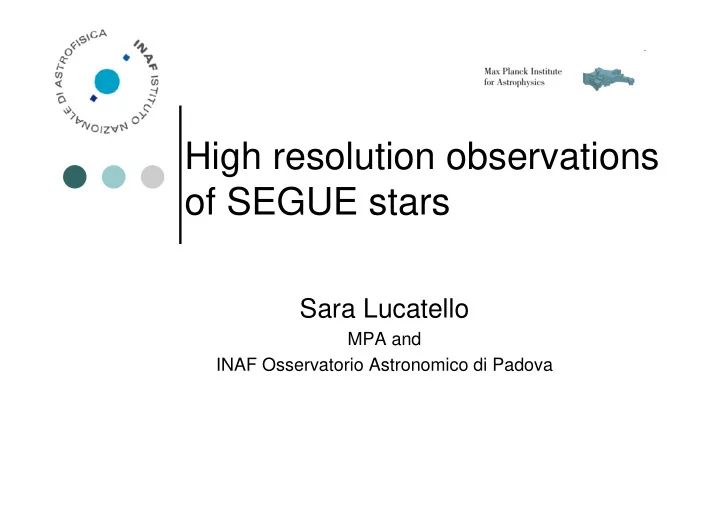

High resolution observations of SEGUE stars Sara Lucatello MPA and INAF Osservatorio Astronomico di Padova
SEGUE � Observations of halo and disk to map position, composition and velocity of >300,000 stars � Tremendous amount of information which presents fundamental contribution to the understanding of the Galaxy (~25 refereed papers to date, many more pertain SEGUE data and 23 more in preparation just from collaboration members!) � Goldmine for target selection for follow up high- resolution observations (reliable atmospheric parameters and metallicities)
From spectra to compositions � Stellar Segue Parameter Pipeline (SSPP Lee et al. 2009) uses multiple approaches to determine atmospheric parameters (6 for Teff +g-r colors, 10 for log g, and 12 for [Fe/H]) in a wide ranges of parameter and S/N � Tested using high-resolution spectroscopy observations of globular (M2, M3, M15) and open clusters (M67, NGC2420) � Field stars are also needed for low ([Fe/H]<~- 2.5) and high ([Fe/H]>-0.5) metallicities, peculiar abundances (C rich, unusual alphas etc)..
High-resolution calibrations � Collective effort, several telescopes and people involved • David Lai • Wako Aoki • Carlos Allende-Prieto • Inese Ivans • Jennifer Johnson • Matt Shethrone • Jennifer Sobeck • Jennifer Simmerer • Sivarani Thirupathi Total 343 objects 240 with S/N>20 Smolinski et al. 2010 • …
SSPP vs HR Smolinski et al. 2010
Subaru Sample Jennifer Simmerer, Inese Ivans et al. � Subaru sample formally 141 stars, 127 usable � 3 w/o SSPP entry, 6 likely double lined binaries, 5 featureless except for H lines •See also Jennifer Simmerer’s talk in SEGUE parallel session (perhaps WD?) •Problem of uniforming the analyses (different people use slightly � Full spectroscopic analysis (log g different toolboxes and this introduces very hard to pinpoint offsets determined not set to 4) (J. Sobeck working on this) � Worked through 1/3 of the sample (46 stars) but enough EW measurements for only 24 stars, some are too low S/N, others too strong CH/CN bands
EMP stars: a little background… � EMP stars probe the characteristics of the first stars, mechanisms of metal production (incl. n-capture elements) in metal poor and/or free environments, IMF in the early Galaxy and nature of the Galactic halo � High-R observations of local EMP stars provide a window on the early chemical evolution of the MW and the involved nucleosynthetic processes. � Lots of open issues still exist, e.g.: discrepancy between Li measured and BBN prediction; very small scatter in alpha and Fe-peak but high in n-capture; metallicity function at the very low end.. � Sample size and sample spatial distribution are two issues, too few targets (rare objects) and not far enough out in the halo
CASH survey Chemical Abundances of Stars in the Halo J. Hollek, A. Frebel, I. Roederer, T. Beers, C. Sneden et al � Aim of constraining early Galactic chemical evolution and look of HMP stars ([Fe/H]<-5) � Collected spectra of ~500 stars with HET (R~15,000) and Mike@Magellan (R~35,000) obtained viable spectra for ~30 SEGUE-I targets (more targeted but very low S/N) � SEGUE targets spectra have only preliminary analysis � Measurements for Fe, Li, C, O, Mg, Ca, Sc, Ti, Ni, Sr and Ba
First stars group Bonifacio et al. � Contributed to calibration stars observations (20 objects with VLT@ESO) � Obtained GTO time on XSHOOTER@VLT to observe ~10 faint targets selected from SEGUE database (public releases) � Do not rely on SSPP for selection � So far two targets observed
Subaru effort W. Aoki, T. Beers, S. Honda, D. Carollo et al. oTwo stars selected from SEGUE on basis of SSPP metallicity and CH band strength oSnapshot style spectra (S/N~30 R~30,000) confirmed them as subdwarfs and found strong Ba lines in one target oHigh Res (R~60,000) found very strong Eu features in SDSS 2357-0052 o[Fe/H]=-3.4 [Eu/Fe]=1.9 Most metal poor r-II star, first r-II stars <-3 Aoki et al.(2010)
Moving into the outer halo o SEGUE provides targets and samples a much larger volume reaching the outer halo � Observational (from SDSS Carollo et Al. 2007, Bell et al. 2008, An et al. 2010) evidence and theoretical models (Bullock & Johnston 2005) suggest that outer halo and inner halo are chemically different � Probing the outer halo in situ provides a more complete picture (local halo stars tagged as outer halo on the basis of kynematics might not be representative)
The Team Sara Lucatello (MPA & INAF) David Lai (UCSC) Connie Rockosi (UCSC) Martin Asplund (MPA) Heather Morrison (CWRU) Jennifer Johnson (OSU) Paul Harding (CWRU) Luca Casagrande (MPA) Remo Collet (MPA) Karin Lind (MPA) Greg Ruchti (MPA) Ivan Ramirez (MPA)
The project � Plan is to compare a sample of outer (d>~ 25kpc) halo stars selected from SEGUE-II with a sample of local halo stars � In situ outer halo: ESI@Keck XSHOOTER@VLT 4200-8000A 3200A-1.1 � m R~ 7,000 8,000-12,000 Fe ,C, N, Ca, Ti, Na, Mg, Ba, Cr, Sr, Eu Most interesting targets will be followed up with higher res observations Inner halo: o UVES@VLT+ HIRES@Keck (Lai et al. 2008) +archives R~40,000 measure Fe, C, N, O, Na, Mg, Al, Si, Ca, Ti, lots of n-capture, Fe-peak etc
Inner vs outer � Awarded 4 ESI nights, 2.5 XSHOOTER, 2 UVES � Total objects observed so far 59 stars (18 more queued), 45 analyzed (preliminary analysis) 89% probability of being a different population
The furthest away stars 2313-53726 1906-53293 [Fe/H] -2.73±0.08 -2.87±0.08 [C/Fe] 0.2±0.1 1.0±0.1 [N/Fe] 0.5±0.2 0.9±0.2 [Na/Fe] 0.30±0.10 1.25±0.05 [Mg/Fe] 0.75±0.15 1.04±0.18 [Ca/Fe] 0.42±0.17 0.58±0.05 [Ti/Fe]II 0.16±0.08 0.30±0.06 [Ba/Fe]II -1.48 -0.77 [Eu/Fe]II <0.49 <-1.1 Distances ~40kpc
Conclusions � We are starting to exploit the capabilities of SEGUE in pre-selecting targets for high-resolution � Calibration is a crucial step that still needs attention � Exciting results are emerging from taking advantage of SEGUE unique ability of reaching into the outer halo � Best part has yet to come!
Recommend
More recommend